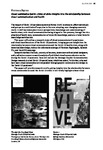Visual communication in a time of crisis: Insights into the relationship between visual communication and health
| dc.contributor.author | Squire, Victoria | |
| dc.date.accessioned | 2022-09-30T13:01:20Z | |
| dc.date.issued | 2022-07-07 | |
| dc.identifier.uri | http://hdl.handle.net/10026.1/19664 | |
| dc.description.abstract |
The impact of Covid-19 has taken numerous forms. It will continue to affect individuals and groups in a multitude of ways, due to the ever adapting, ever changing uncertain world. A shift has taken place in our perspectives, knowledge and understanding of health crises, with visual communication being integral to this process; through the visualization of health data, communication of scientific knowledge, and as a crucial force for knowledge mobilization. This paper will outline a research study of visual communicators’ experiences and visual manifestations of the Covid-19 pandemic, bringing greater insight into the relationship between visual communication and the Covid-19 health crisis, along with historical knowledge, such as the information design of Florence Nightingale, Spanish Flu, and the AIDS campaign. Research methods include, a survey of sources, interviews with selected designers, and qualitative content research analysis of published visual communication works during the Covid-19 pandemic. Data will include the Message Graphic Communication Design research journal Covid-19 special issue, which has asked, “with what, why and how have visual communicators responded through graphic communication design to the Covid-19 pandemic.” The paper will provide research results, giving insights into the relationship between visual communication and the Covid-19 crisis. It will briefly highlight where visual communicators’ have contributed, for example, inspiring and capturing new ways of teaching and learning; reaching out and collaborating with communities; seeking solace in practice to provide comfort to themselves and others. The focal point will be the relationship between visual communication and health. This will include examples such as, using visual communication as a means of escape and refuge during isolation; capturing and portraying emotions, disturbance or tension, improvement and healing; communicating positive messages back to oneself and to others. Finally, the paper will speculatively question the future of visual communication and health highlighting examples such as, where, and how can visual communication capture feelings and emotions when supporting the processing of fear and uncertainty? How and why is graphic co-creation supportive to the health of community? Can visual communication create empathy and kindness in others through capturing the voices of individuals in challenging situations? | |
| dc.language.iso | en | |
| dc.subject | Covid-19 pandemic | |
| dc.subject | graphic design | |
| dc.subject | health | |
| dc.subject | visual communication | |
| dc.title | Visual communication in a time of crisis: Insights into the relationship between visual communication and health | |
| dc.type | presentation | |
| plymouth.date-start | 2022-07-07 | |
| plymouth.date-finish | 2022-07-09 | |
| plymouth.date-finish | 2022-07-09 | |
| plymouth.conference-name | 8th International conference on Typography and Visual Communication | |
| plymouth.organisational-group | /Plymouth | |
| plymouth.organisational-group | /Plymouth/Faculty of Arts, Humanities and Business | |
| plymouth.organisational-group | /Plymouth/Faculty of Arts, Humanities and Business/School of Art, Design and Architecture | |
| plymouth.organisational-group | /Plymouth/Users by role | |
| plymouth.organisational-group | /Plymouth/Users by role/Academics | |
| dc.publisher.place | 8th International conference on Typography and Visual Communication, 7 - 9 July 2022 | |
| dcterms.dateAccepted | 2022-02-06 | |
| dc.rights.embargodate | 2022-10-6 | |
| dc.rights.embargoperiod | Not known | |
| rioxxterms.licenseref.uri | http://www.rioxx.net/licenses/all-rights-reserved | |
| rioxxterms.type | Conference Paper/Proceeding/Abstract |


